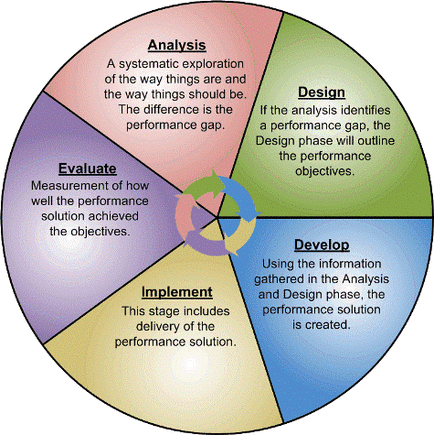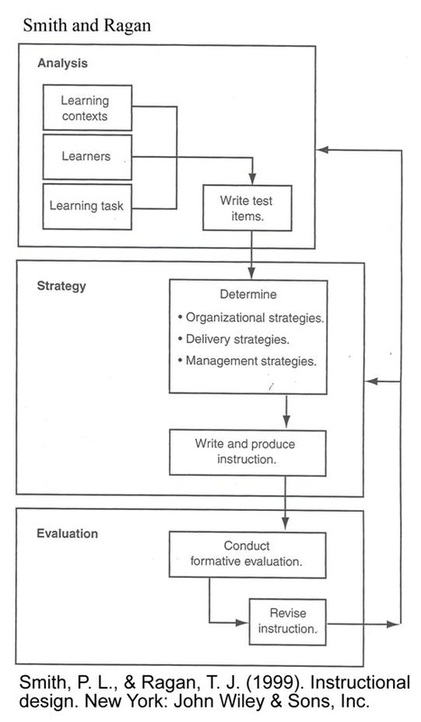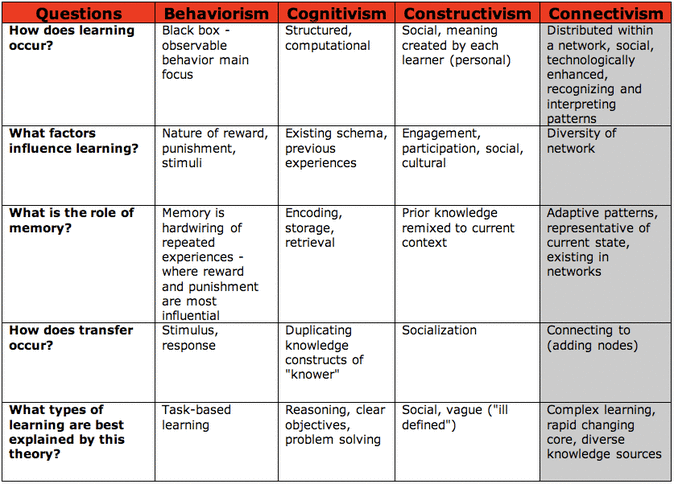Instructional Design Strategy

1. Introduction
1.1. Purpose and Context
In Australia, Australian Financial Group (AFG) employ over 3,000 people, 480 of which are finance and mortgage brokers. The company's offerings are regulated by the Australian Securities and Investments Commission (ASIC), federal government regulators. In 2011, ASIC replaced the existing state based regulations with a uniform nationwide National Consumer Credit Protection (NCCP) Act, requiring that all brokers be trained immediately in order to remain compliant.
AFG has engaged the services of LovingLearning.com.au, a Brisbane training organization, to conduct the work. As is usual with compliance training, the company is interested in gaining a tangible record of all training outcomes to provide evidence to ASIC in the event of an audit. LovingLearning.com.au habitually use the ADDIE model of instructional design (Appendix 1.), however in this case the client (AFG) has commissioned a more strategic analysis before proceeding with the proposed work. LovingLearning.com.au’s model of choice then, is the Smith & Ragan model (Smith & Ragan, 2004). This model presents opportunities to highlight analysis, strategy and evaluation (Appendix 2.)
The nature of the program content is highly prescriptive. This being the case, the underlying theoretical perspective utilised will be behavioural learning theory and Gagné’s nine events of instruction (Appendix 3.). Moreover, LovingLearning.com.au will conduct an analysis on the organizational context in which they will deliver the learning program.
This will involve looking at the learners themselves, their surroundings, their working conditions, pre-existing knowledge, goals, assessment needs along with resources, both those available and those required.
In addition, LovingLearning.com.au will work with the AFG subject matter experts and management to ensure the content presented is contextualised in alignment with broader organisational needs and business imperatives.
The program will be delivered via eLearning, as the brokers are geographically dispersed and the organization cannot afford for the message to be diluted in any way by being delivered on a face to face basis. The modules will be available via the AFG Learning Management System (LMS), and will comprise four one hour sessions, to be completed at any time over the course of one week. Upon completion a full report will be generated for senior management, highlighting the time taken to complete, passing marks and number of attempts made by brokers.
1.2. Instructional Problem
AFG does not currently have the capability to design, deliver, administer or evaluate a training program. LovingLearning.com.au has been asked to provide a strategic scope with a view to delivering the training immediately following its successful presentation to the board.
AFG are particularly concerned with the fact that the new legislation has seen 20% of their brokers leave the organization (and most, the industry entirely) due to the additional pressure of compliance. The ramifications of non-compliance with the ASIC legislation are $220,000 for individual brokers and $1.1M for corporations, not to mention the public relations implications. AFG have specifically requested that the LovingLearning.com.au team ensure that the training is done in such a way that does not alienate or overwhelm the brokers with ‘legalese’.
2. Theoretical Approach
Smith and Ragan (2005) describe an instructional model involving three steps; analysis, strategy and evaluation. In the case of AFG, the questions are, what needs to be covered, how will it be done and what evidence will be left that it was done right? These steps are important to delineate in such a complex subject matter as legislation.
2.1. Behaviourism
The subject matter being legislation, the most appropriate learning theory is behaviourism. This theory, as Gredler describes in 2001, makes three assumptions about learning. Firstly, that observable behaviour is more important than understanding internal activities. Secondly, that behaviour should be focused on simple elements such as specific stimuli and responses, and lastly that learning is primarily focused on behaviour change. From a content creation and assessment methodology, there is certainly merit to utilizing this theory in this case.
2.2. Connectivism
Whilst behaviourism is a useful theory for linear, structured and more traditional training, it may be limited in terms of the learning environment of 2011. Siemens proposed a theory of connectivism (Appendix 4.), where “connectivism is driven by the understanding that decisions are based on rapidly altering foundations. New information is continually being acquired and the ability to draw distinctions between important and unimportant information is vital. Also critical is the ability to recognize when new information alters the landscape based on decisions made yesterday” (Siemens, 2005, para. 24). Siemens is concerned with learners knowing not just “what and how”, but where to acquire knowledge.
Both the principles of connectivism and behaviourism will guide and inform the creation of the eLearning module, for the following reasons. Brokers are uniquely subjected to changes in legislation. Behaviourism dictates that the eLearning module focus on what needs to be done to comply, and the exact steps it takes to do it. This is important today, but where to find the information with which to comply tomorrow, next week and next year?
In this case, the course will offer not only this information but introduce the brokers to dynamic and growing pathways through which they may remain up to date. These may be online forums, LinkedIn, Twitter and/or Facebook applications.
The traditional learning theories are by no means obsolete, they simply must be considered from the perspective of the most rapid change in technology and information systems in history. The brokers must understand, as Vaill put it in 1996, that learning is now simply a way of being.
3. Philosophical Approach
3.1. Pragmatism
The philosophical perspective for this intervention is Pragmatism, which Driscoll described in 1994 as the “middle ground” between constructivism and empiricism. It partners well with connectivism, as John Dewey explained in 1938. He believed that learners must adapt to both one other and to their environment. In this case, he would probably not have imagined iPhones and eLearning, however the philosophy of first considering the experience of the learner aligns well with Siemens notion that learning now is more about using the context, in this case technology, to liberate the learner from the knowledge itself by creating an external bridge “to” it.
Using these philosophies as a guide, LovingLearning.com.au will create a program that focuses on problem solving and fosters collaborative learning. Rather than simply listing the legislation and demanding rote learning, learners will be able to apply their existing knowledge to real broker simulations. This will prepare them more readily for on-going compliance (Cohen and Gelbrich, 1999).
3.2. Experiential Learning
Carver et al (2007) offer a model for eLearning instruction called “Experiential eLearning”, using as its basis experiential education, which involves learning activities in which the student is directly engaged in the phenomena being studied (Cantor, 1997). Carver et al present a taxonomy of experiential eLearning which consists of six “types” and, when combined with Gagné’s model, serve to provide a framework on which LovingLearning.com.au can create a quality learning intervention which serves both the needs of the individual learner and the organisation as a whole.
In this case, the “type” most suitable is the Type 5 eeLearning, which is problem based/service learning. This type centres on a course created around real problems in an actual organization. Learners participate vicariously in a constructed experience in order to learn how to most effectively accommodate the changes in legislation brought about by ASIC.
The power of this model for eLearning is in its offering of an explicit, highly credible learner centred instructional model based on learner engagement and competence (Carver, 1996). These theories will be combined with Gagné’s instructional events and utilized by the LovingLearning.com.au team in creating the AFG learning modules.
4. Strategies
Gagné’s position on instruction is that it must be designed specifically in the context of the learner's needs, in this case the brokers. The brokers are from a diverse background, both in terms of their experience and their culture, which will be explored later. LovingLearning.com.au intends to use instructional design strategies centred on Gagné's (1985) nine instructional events.
Behavioural models also include an awareness of consequences as providing a useful basis on which to present training, citing the nature of reward, punishment and stimuli as being primary considerations when looking at factors influencing learning (Ireland, 2007). The learning involved in this project is indeed motivated in this manner. Moreover, the “punishment” could be as high as a $220,000 fine. Further, as Shambaugh and Magliaro described in 1997, given the urgency of the training, this factor will be useful in ensuring the learners enact behavioural change.
LovingLearning.com.au will conduct a gap analysis, to ensure that the information presented in the course fulfils the requirements and that the learners existing knowledge is taken into account. The learning goal will therefore be developed from the results of this analysis.
In 1983, Reigeluth suggested that instructional strategies are made up of organisational strategies, delivery strategies and management strategies. Organisational strategy is concerned with how learning is sequenced, with the content and how it will be presented (Smith & Ragan, 2005). In this program, the learning will follow a natural pathway along a simulated broker/client interaction, and will ask the broker to interact with choices along the timeline.
In this way, the eLearning program will “supplant or scaffold” more of the required content by explicitly supplying all the events of instruction (ibid, p.142). These supplantive strategies allow the learner to focus on the required behaviours, rather than on constructing their own meaning (ibid). The resulting content will be informed by the gap analysis.
Smith and Ragan (2005) describe the delivery strategy as concerning the instructional medium and the grouping of learners. As the audience for the program is geographically dispersed, the ideal instructional medium is eLearning, accessible through the intra/internet on smartphones, iPads and other devices.
Management strategy involves looking at scheduling and allocation of resources (Smith & Ragan, 2005). As AFG is outsourcing this project and have no internal resources with the requisite knowledge, LovingLearning.com.au will utilise the resources provided by the industry body, the Mortgage Finance Association of Australia (MFAA). Their availability will be up to 4 hours per day, which will be more than generous.
5. Analysis
5.1. Learners
In 1990, Dick and Carey explained the importance of understanding the learner. The AFG brokers are diverse in their cognitive ability, previous experience, motivation, personal learning style, attitudes, and more. There are other considerations such as gender, cultural background, literacy and approach to instructional medium which also may impact the success of the training (Smith & Ragan, 2005).
They share one thing in common, however. They all hold a Certificate IV in Financial Services. This being the case, a certain level of cognitive ability and motivation can be assumed. This, along with LovingLearning.com.au ’s extensive experience in designing and delivering for mortgage brokers, contributes to a high level of confidence in being able to deliver a successful program for all learners.
5.2. Context
The learning context is often overlooked in the instructional design process, as the designer may not be connected with the delivery of the program, or they may not see it as part of their role to consider it (Dick and Carey, 1990). The training will be delivered via computer and mobile devices and as such, direct supervision will not be possible. In catering for this, LovingLearning.com.au will ensure AFG provide a sufficient level of support via telephone to learners who need assistance. This assistance will be provided by senior brokers for whom the new legislation presents no issue.
As this training is being delivered via technology, usability factors such as PC/Macintosh compatibility and software upgrades must be considered. Delivery will cater to both Android and Apple iOS platforms, ensuring a uniform level of access and quality for all learners.
5.3. Learning Goal
The learning goal for this program will be:
The learner will be able to identify all relevant requirements of the new NCCP legislation in the area of mortgage and finance broking, in addition to the responsibilities and ramifications of non-compliance. They will also be able to demonstrate the knowledge and skills required to maintain on-going compliance in both verbal and written communication.
The learning goal will then inform a set of learning objectives, which will be performance based and linked to real documentation and case studies. According to Ertmer & Newby (1993), "behaviourism equates learning with changes in either the form or frequency of observable performance". Once the brokers can demonstrate the appropriate response in the face of a true to life simulation, we will know learning has been achieved. The learning objectives are detailed in Section 5.5.
5.4. Types of knowledge
The brokers are concerned with two questions; what do I need to know and what do I have to do? Gagné, and Yekovich (1993) would describe these questions as addressing declarative knowledge and procedural knowledge respectively. Declarative being knowledge of facts, theories and objects, with procedural being knowledge of how to do something (ibid).
Declarative knowledge predominates in this course. The brokers have existing knowledge, and therefore this will inform the manner in which the scaffolding occurs (Vygotsky, 1986). Learners will need to absorb the principles and responsibilities of becoming a credit license holder, responsible lending guidelines and what is listed on new information statements.
Procedural knowledge required by the brokers in this program will comprise how to complete and submit an application, provide appropriate identification and verification from clients and what steps they must follow should they become suspicious about a client’s actions.
The approach LovingLearning.com.au will take in the course will be a mix of guided discovery and expository instruction. Given the time restrictions (the brokers count their time very much in terms of money and lost income) they may not have much patience for guided discovery methodology, however according to Mayer (2002) it has been proven to result in better long term retention and transfer. This will be achieved by providing the learners with real documents as a reference for the assessment questions.
However successful this method may be, the finance industry is well known for wanting a more explicit and expository approach. Mayer maintains that expository instruction does not encourage learner to actively think, but it is effective in ensuring that the rule is learned (ibid).
5.5. Analysis of assessment
LovingLearning.com.au Learning Objectives for AFG brokers are as follows:
Describe the role of ASIC in regulating mortgage & finance brokers
Explain the 7 relevant changes to the NCCP Act
Correctly identify potential breaches of the legislation
Demonstrate the usage of a responsible lending form
Describe the steps involved in gaining a credit license
Identify stages of risk for a broker
Correctly identify the levels of breach
Explain the purpose of information sheets
Locate required information on the AFG intranet
Demonstrate correct usage of all 4 relevant forms
Online assessment will be highly valid as it will mirror the exact steps involved in dealing with customers (Booth et al, 2004). The assessment will take the form of multi-choice, short answer, drag and drop and sequencing in addition to having to submit finished paperwork for case studies.
Criticisms of these assessments extend to too few items, limited range of scores, inadequate testing conditions and subjective scoring (Gronlund, 2009). In this case, however, the assessment plan and its objectives were designed with consideration for the applicability and authenticity of the required items, as Gulikers et al proposed in 2004.
The assessment is fair due to the clear and unambiguous nature of the expectations, in addition to the provision of phone support should they require it. It is flexible, in that there could be no more delivery platforms or ways in which the brokers may complete the module. That is, they may do it at work, at home or whilst commuting and on all manner of devices.
In addition, the plan is cohesive, as the methods utilized in the assessment are consistent with the program outcomes and learner needs, as they provide the most direct method of broker performance as specified by the outcomes (Gronlund, 2009).
5.6. Instructional events
These events provide the necessary conditions for learning and serve as the basis for designing instruction and selecting appropriate media, interactions and content (Gagné, Briggs & Wager, 1992). Gagné’s nine expanded events (Smith & Ragan, 2005) will inform the instructional events as follows:
1. Gaining attention – Case studies of recent broker fines.
2. Informing learner of objective/s – Audio introduction, learning goal and objectives, course tour.
3. Stimulating recall of prerequisite learning – interactive fact checker, existing legislation versus NCCP Act and broker video profile.
4. Presenting the content – NCCP Act highlights, new requirements interaction, drag and drop hierarchy of priorities, Find The Fault exercise.
5. Providing learning guidance – HelpHint button links to an audio file to assist long term semantic encoding (Tulving, 1990). 1300 phone support.
6. Eliciting performance – Client case studies. Learners will also be invited to participate in a constructivist style synchronous webinar to role play potential pitfall areas (Stollings, 2007).
7. Providing feedback – Immediate informative and motivational feedback, both utilizing subsequent practice opportunities (Smith & Ragan, 2005).
8. Assessing performance – Formative and summative assessment throughout the module. Interpret and extrapolate solutions in various ways during the program to embed concepts and procedures.
9. Enhancing retention and transfer – Automated function of invitations to complete additional case studies post completion - once a week for one month, to scaffold and support their on-going retention (Gagné, 1985).
6. Resources
Resources that will be required/developed for the instruction are:
NCCP Act (2010) – A copy of the Act will be included in the module. This is provided as a part of the ASIC requirements.
AFG Compliance Policy – AFG expectations of broker representatives, also included in the attachments.
eLearning Module – Encompassing images, audio, video and text files, this animated and interactive module will deliver all necessary content to learners in the most engaging manner possible.
Quizmaker Assessment – This summative quiz will allow brokers to demonstrate both declarative and procedural knowledge. It will be available separately to allow brokers to revisit the content and potentially take the quiz before completing the content itself.
NCCP Webinar – Interactive Case Studies – this constructivist activity will allow brokers to learn in a non-threatening and collaborative environment, further embedding and scaffolding existing knowledge gained in the module and from personal experience.
7. Conclusion
LovingLearning.com.au will deliver an eLearning program using the Smith and Ragan instructional design model, which will provide AFG with an engaging and effective solution to the problem of regulatory compliance. The nature of the training, along with the expectations of AFG demands a behavioural approach, which will be partnered with aspects of connectivism when marrying content with delivery methodology. This approach offers flexibility, dynamism and interactivity in achieving the desired learning goal and objectives.
Learners will apply declarative and procedural knowledge to a structure guided by Gagné’s instructional events. The pragmatic philosophy will offer delivery over multi-platform technologies with both synchronous and asynchronous elements, ensuring the learners are able to interact with each other, a help centre and their learning environment effectively. LovingLearning.com.au will conduct a pilot program of 15 learners with interviews and full evaluations, giving a chance to ensure the program meets the precise organizational and individual requirements before commencing delivery to the broader organization shortly thereafter.
8. References
Booth, R., Roy, S. & Clayton, B. (2004), Maximising Confidence in Assessment Decision-Making: Current Approaches and Future Strategies, NCVER, Adelaide.
Cantor, J. A. (1997). Experiential learning inhigher education. Washington, DC: ERIC Clearinghouse on Higher Education.
Carver, R. (1996). Theory for Practice: A Framework for Thinking about Experiential Education, Journal of Experiential Education, May/June 1996 (Vol. 19, No. 1).
Carver, R., King, R., Hannum, W. H., & Fowler, B. (2007). Toward a model of experiential e-learning. MERLOT Journal of Online Learning and Teaching, 3, 247-256.
Cohen, L. and Gelbrich, J. (1999). "Module One: History and Philosophy of Education". Retrieved September 4, 2011 from Ohio State University website: <http://oregonstate.edu/instruct/ed416/module1.html>.
Dewey, J. (1938) Experience and Education, New York: Collier Books. (Collier edition first published 1963)
Dick, W. & Cary, L. (1990), The Systematic Design of Instruction, Third Edition, Harper Collins
Driscoll, M. P. (1994). Psychology of learning for instruction. Boston: Allyn and Bacon.
Ertmer, P. and Newby, T. (1993). Behaviourism, cognitivism, constructivism: Comparing critical features from an instructional design perspective. Performance Improvement Quarterly, 6 (4), 50-72.
Gagné, R. M., (1985) The Conditions of Learning and Theory of Instruction. New York: CBS College Publishing.
Gagné, E. D., Yekovich, C. W., & Yekovich, F. R. (1993). The cognitive psychology of school learning. (2nd ed.). New York: HarperCollins.
Gonzalez, C. (2004). The role of blended learning in the world of technology. Retrieved September 5, 2011 from http://www.unt.edu/benchmarks/archives/2004/september04/eis.htm
Gronlund, N. E. & Waugh, C. K. (2009). Assessment of student achievement (9th ed.). New Jersey: Merrill-Pearson.
Gulikers, J., Bastiaens, Th. & Kirschner, P. (2004) A five-dimensional framework for authentic assessment, Educational Technology Research and Development, 52(3), 67-85.
Ireland, T. (2007). Situating connectivism. Retrieved September 5, 2011, from http://sites.wiki.ubc.ca/etec510/Situating_Connectivism
Krause, K., Bochner, S., Duchesne, S. (2003). Educational Psychology for learning and teaching. Victoria: Thomson.
Mayer, Richard, E. The Promise of Educational Psychology Volume II: Teaching for Meaningful Learning. Pearson Education, Inc., New Jersey, 2002.
Reigeluth, C. (1983). Instructional design theories and models; an overview of their current status. Hillsdale, NJ: Lawrence Erlbaum.
Siemens, G. (2005, January). Connectivism: A learning theory for the digital age. International Journal of Instructional Technology & Distance Learning
Shambaugh, Neal R. & Magliaro, Susan G. (1997). Mastering the possibilities, A process approach to instructional design, Needham Heights, Allyn and Bacon.
Smith, Patricia L. & Ragan, Tillman J. (2005). Instructional Design, 3rd, Holboken, NJ: John Wiley & Sons
Stollings, L. (2007). Robert Gagné’s nine learning events: Instructional design for dummies Retrieved on 10 September 2011 from: http://sites.wiki.ubc.ca/etec510/Robert_Gagné%27s_Nine_Learning_Events:_Instructional_Design_for_Dummies
Tulving, E., & Schacter, D.L. (1990). Priming and human memory systems. Bum. Science, 247, 301 – 306.
Vaill, P. B., (1996). Learning as a way of being. San Francisco, CA: Jossey-Bass Inc.
Vygotsky, L.S. (1986) Thought and Language. Boston: MIT Press
9. Legislation
The National Consumer Credit Protection (NCCP) Act 2010 – Australian Government
10. Appendices
1. ADDIE Instructional Design Model
2. Smith and Ragan’s Instructional Design Process Mode
3. Gagné’s 9 Instructional Events
4. Siemens Theory of Connectivism
10.1. Appendix 1 – ADDIE Instructional Design Model

10.2.Smith and Ragan’s Instructional Design Model

10.3. Gagné’s 9 Instructional Events

10.4. Siemen’s
Theory of Connectivism


